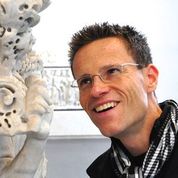Affiliation: Southern Illinois University

Mont Allen is Associate Professor of Classics and Art History at Southern Illinois University. He holds degrees in Art History (Ph.D.), European History (M.A.), and Geography (B.A.) from U.C. Berkeley, and in the History of Religion (M.A.) from Syracuse University. His areas of specialization include Greek and Roman funerary sculpture, ancient sculptural tools and techniques, Greek mythology, Roman painting, and Late Antique religions. Professor Allen is a recipient of his university’s Outstanding Teacher of the Year Award (2018). His book on the strange disappearance of Greek mythological scenes from Roman coffins during the third century — titled The Death of Myth on Roman Sarcophagi: Allegory and Visual Narrative in the Late Empire — is currently in production with Cambridge University Press.
Why are roughly one-ninth of all surviving Roman sarcophagi shaped not like rectangular boxes with squared-off ends, but instead like lenoi: those large tubs or vats with rounded ends in which Greeks and Romans pressed grapes and fermented the juice to make wine, an association underscored by the Dionysiac imagery that often appears on the sides of these lenoid sarcophagi? What purpose did it serve within the funerary context? Or to put it most bluntly: Why did so many Romans want to imagine their dearly departed as resting within a wine vat?!
I suggest that it explicitly invited viewers — bereaved family members — to reconceive the corpse’s decomposition and moldering within the vat-like casket in Dionysiac terms: as a process of fermentation like that which transformed grapes into wine. It offered mourners a comforting fantasy, to reimagine the deceased’s putrefaction as instead a transubstantiation into a delicious elixir, something elevated, intoxicating, and divine. Exploring a wide variety of evidence — archaeological and taphonomic — this talk examines the plausibility of such an argument, with special attention paid to what we can reconstruct about how Romans would have liquefied within their sarcophagi.
A strange thing happens to Roman sarcophagi of the Late Empire: their mythic imagery vanishes. These lavishly carved coffins had featured bold mythological scenes since the very beginning of their mainstream production early in the second century AD, when burial had replaced cremation as the favored means for disposing of the dead. Evocative testament to Rome’s ongoing love affair with classical Greek culture, they derived visual force from their resonance with an artistic tradition centuries old while providing catharsis and consolation to those still living. How then to make sense of this imagery’s withering and final abandonment on later sarcophagi, as mythological narratives were truncated, gods and heroes were excised, and genres featuring no mythic content whatsoever came to the fore?
That it must represent a major shift in the cultural values of the Late Empire is a given, given the central position that sarcophagi occupied in the Roman visual imagination. But no consensus exists regarding its significance and the factors that may have driven it. Did it perhaps reflect the growing strength of Christianity? The political disenfranchisement of Rome’s old elite? The cultural illiteracy of its new? A desire for scenes of peace and tranquility as antidotes to the horrors of the Third Century Crisis? An eagerness for imagery more finely tuned to status display? A trivialization of myth caused by its excessive use? Or something else entirely?